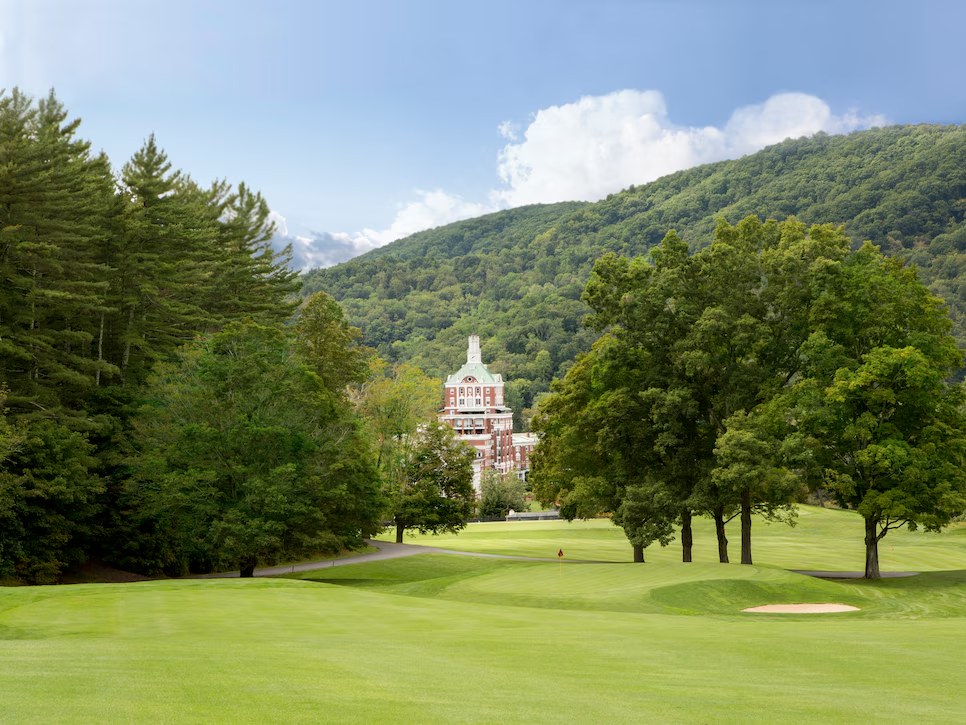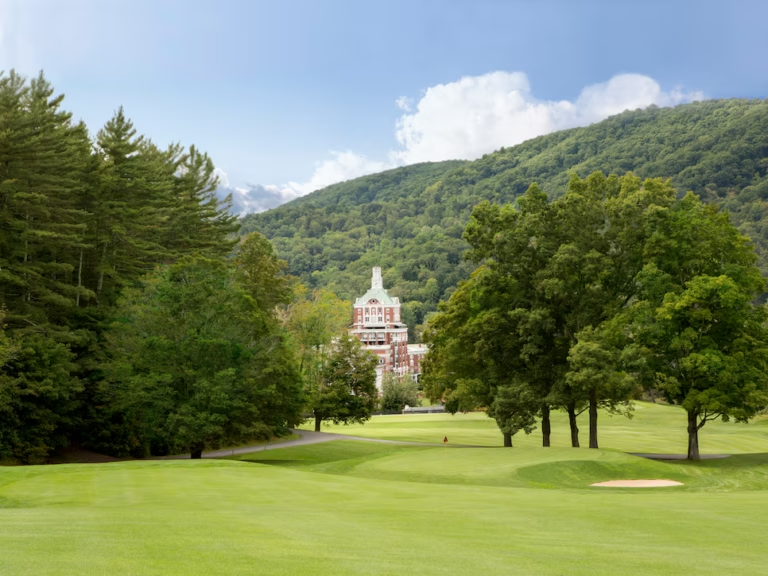Golf at Hot Springs predated Ross. The resort opened a six-hole course in 1892, with nine holes recorded later that decade and, by some accounts, a full eighteen by 1901. In 1913, the resort engaged Donald Ross to redesign the Old Course. Contemporary and retrospective resort materials characterize his commission as the moment the course assumed modern dimensions and characteristics for mountain play. There is, however, a tension in the record: some narratives credit Ross with expanding a nine-hole course to 18 in 1913; others state that the property already had 18 by 1901 and that Ross redesigned those 18 in 1913.
The course subsequently saw additional work. William S. Flynn is credited by the resort and several golf publications with “updates” to the Old Course in the 1920s (many list 1925). The scope and specific hole-by-hole changes attributed to Flynn are not detailed in accessible sources, and no Flynn drawings for the Old Course are publicly cited online. In the modern era, a 1994 renovation by Rees Jones altered specific playing corridors near the hotel, including adjustments to the first and eighteenth holes and the addition/relocation of practice facilities. These interventions explain the current par-3 finishing hole and the presence of a full range on the hotel side—features not necessarily consistent with a 1913 Ross configuration. The resort has undertaken ongoing tree management and presentation updates in the last decade, guided in part by historic imagery from the 1920s, but those works have not been publicly framed as a Ross restoration.
Unique Design Characteristics
Whatever the exact baseline in 1913, the Old Course that visitors see today exhibits a set of features that align with what the resort’s own hole-by-hole tour describes. False fronts and elevated green pads recur: No. 3 (par 5) ends on a green with a “steep false front,” No. 6 (par 4) plays to an “elevated green with a severe false front,” and No. 8 (short par 4) requires a properly flown approach “avoiding the severe false front.” The No. 16 par three is also played to an “elevated green protected…by deep bunkers,” with a surface that falls from left to right and back to front. Blind or semi-blind driving zones—mountain-site necessities Ross frequently accommodated elsewhere in this era—appear on No. 4 and No. 10, and the hole tour emphasizes downhill or sidehill lies into smallish targets, particularly on Nos. 10, 12, and 13. Bunkering includes flanking hazards at key greens (the No. 11 par three is “protected on both sides by huge bunkers,” while No. 17’s approach must navigate a “very large deep bunker” right front).
Two routing signatures stand out. First, the course’s balance of six par 3s, six par 4s, and six par 5s is unusual and shapes rhythm throughout the round; second, there are back-to-back par fives twice—Nos. 3–4 outward and Nos. 12–13 inward—followed by a distinctive par-3 finish at No. 18 that drops from an elevated tee toward the hotel. These arrangements heighten variety and keep approach clubs changing constantly. While the distribution we see now reflects twentieth-century changes after Ross (most notably in 1994 near the clubhouse), the core themes described on the resort’s own hole tour—smallish, elevated targets and active fairway contours—align with the kind of contouring attributed to Ross’s 1913 work in secondary accounts.
In terms of surviving “feel,” the clearest places to study early-era green-site presentation are Nos. 3, 6, 8, 12, and 16, where the resort’s descriptions reference strong back-to-front fall and/or pad-style elevations that read as classic mountain-Ross solutions to drainage and angle. Without dated construction photos or Ross’s detailed field sketches in hand, one cannot assert that any individual green contour remains precisely as he built it; but these complexes, taken together, preserve the period’s strategic cues on the ground.
Historical Significance
Within Ross’s portfolio, Homestead’s Old Course marks a 1913 commission at a national resort that already had a public profile—highly visible, if not among his most celebrated designs. Its historical identity is tied to the first tee (1892), which the resort promotes as the oldest in continuous use in the United States, and to presidential play; William McKinley is repeatedly cited as the first sitting U.S. president to tee off here (1899), with subsequent presidential rounds by Taft, Wilson, Eisenhower, and Ford recorded in resort histories and contemporary travel journalism. While the Cascades course (1923, by Flynn) hosted national championships and draws most connoisseur attention, the Old Course matters in telling the Homestead’s story and in documenting how a pre-Ross resort course was brought into modern, 18-hole form during Ross’s most productive decade—and then evolved further under Flynn and Rees Jones. Modern publications frequently cite the Old Course’s balanced set of par values and its ranking among Virginia public/resort courses; those assessments, while promotional, keep the Ross connection visible to non-specialist audiences.
Current Condition / Integrity
Routing and scale. The routing visible today—returning nines, holes climbing and descending the hills in short bursts, tight proximity to the hotel at both ends—reflects an accretion of eras. In particular, clubhouse-side corridors have been materially altered: the first hole is now a par five, and the eighteenth plays as a par three back toward the clubhouse; changes associated with the 1994 Rees Jones work provided space for a modern driving range near the hotel. The resort’s attribution of “updates” to William S. Flynn (1920s) further confirms that the course did not remain in a fixed Ross state after 1913.
Greens and bunkers. The hole tour’s descriptions of false fronts (3, 6, 8, 15), elevated targets (6, 16), and protective flanking bunkers (11, 17) show a house style that, at a minimum, preserves early twentieth-century strategic expressions. Whether these specific contours are Ross’s hand or later interpretations remains unverified in the absence of primary drawings or dated construction photos. Aerial comparisons from the 1920s reportedly inform current presentation choices (tree management and views), but no official green-by-green restoration narrative is public.
Trees, turf, and presentation. Over the last decade the resort has removed select trees to reopen vistas and revive play corridors akin to those seen in 1923/1925 imagery; this is presentation work, not documented as a Ross restoration. Turf varieties have modernized as expected for a high-elevation resort course.
Bottom line on integrity. The Old Course today retains Ross-era scale and strategy in places—notably at pad-style greens and on hillside fairways—but the finishing stretch and practice-side routing reflect 1990s priorities, and Flynn’s intermediate-era work likely reconfigured additional holes.
Documented uncertainties.
• Baseline in 1913 (9 vs. 18 holes). Some resort histories say Ross expanded a nine-hole layout to 18 in 1913; others state 18 existed by 1901 and Ross redesigned those 18 in 1913. Without club minutes or Ross plans, both phrasings circulate in credible secondary sources.
• Flynn’s scope (1920s). Multiple sources credit William S. Flynn with 1920s updates (often 1925), but do not publish hole-by-hole scope; primary Flynn drawings have not been located online.
• Rees Jones (1994) specifics. Journalistic accounts attribute the first becoming a par five and practice-range related changes, and note a par-3 finisher; a formal as-built plan set would be needed to assign every bunker or green contour in the clubhouse corridor to this phase.
• Original architect (1892/1896/1901). None of the resort-facing or trade sources consulted identify a named architect for the earliest six- or nine-hole versions; authorship likely resides in hotel or local records not available online.
Sources & Notes
Omni Homestead — Old Course page. Yardage, par, 6-3/6-4/6-5 balance; acknowledgement of later work by Flynn and Rees Jones; public positioning of the first tee and current tee/ratings.
Historic Hotels of America — Golf at The Homestead. Chronology stating six holes (1892), nine (by 1898), and Ross expansion to 18 in 1913; also contextual presidential play references.
Historic Hotels of America — Resort History page. Alternate chronology stating expansion to 18 by 1901 and Ross “redesign” in 1913 (illustrates the nine-vs-eighteen uncertainty).
Homestead Members — Old Course Tour (hole-by-hole). Primary current source for specific features: false fronts at 3/6/8/15, elevated greens at 6/16, flanking bunkers at 11/17, blind landing areas at 4/10, and par-3 No. 18 finish with distances.
Sports Illustrated/Golf.com travel feature (2018). Presidential play claims (McKinley in 1899, and others) tied specifically to the Old Course.
GolfPass course profile (2015). Describes the resort bringing in Ross in 1913 and attributes fairway contouring (sidehill/uphill/downhill lies) and smaller greens to that work; a secondary source but widely circulated.
Cigar Aficionado (1998) feature on Homestead golf. Notes Rees Jones (1994) changed the first hole to a par five and moved the 18th to create space for a driving range; corroborates why the finish is a par 3 near the clubhouse.
GolfPass “Old Course” page and Links Magazine pieces.** Reiterate the 6-3/6-4/6-5 balance and place the Old Course within Virginia resort rankings and travel coverage; useful for current public reputation.
Press release (Historic Hotels, 2023 “Top 25 Golf”). Repeats six-to-nine-to-eighteen narrative with Ross’s 1913 expansion; shows the resort’s own messaging in a semi-official historical venue.
Wikipedia (Homestead Resort). States 18 by 1901 and Ross redesign 1913; tertiary but useful to illustrate the conflicting narratives that require primary verification.

